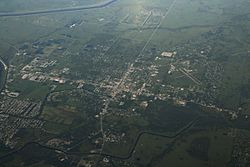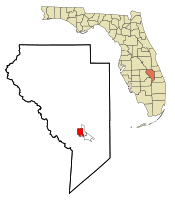Okeechobee, Florida facts for kids
Quick facts for kids
Okeechobee, Florida
|
||
|---|---|---|
| City of Okeechobee | ||

Aerial view of the city in 2013
|
||
|
||

Location in Okeechobee County and the state of Florida
|
||
| Country | United States | |
| State | Florida | |
| County | Okeechobee | |
| Incorporated | June 4, 1915 | |
| Government | ||
| • Type | Mayor-Council | |
| Area | ||
| • Total | 4.15 sq mi (10.76 km2) | |
| • Land | 4.06 sq mi (10.50 km2) | |
| • Water | 0.10 sq mi (0.25 km2) 0.96% | |
| Elevation | 26 ft (8 m) | |
| Population
(2020)
|
||
| • Total | 5,254 | |
| • Density | 1,295.36/sq mi (500.20/km2) | |
| Time zone | UTC−5 (Eastern (EST)) | |
| • Summer (DST) | UTC−4 (EDT) | |
| ZIP codes |
34972-34974
|
|
| Area code(s) | 863 | |
| FIPS code | 12-51200 | |
| GNIS feature ID | 0288073 | |
| Website | http://www.cityofokeechobee.com | |
Okeechobee (US: /oʊkiˈtʃoʊbi/ OH-kee-CHOH-bee) is a city in and the county seat of Okeechobee County, Florida, United States. As of the 2020 US census, the city's population was 5,254.
The Lake Okeechobee area was severely damaged in the 1928 Okeechobee Hurricane, the first recorded Category 5 hurricane in the North Atlantic. This was one of the deadliest hurricanes ever to strike the US.
Okeechobee is served by the Okeechobee County Airport.
History
Okeechobee is close to the site of the Battle of Lake Okeechobee, a major battle of the Second Seminole War, fought between forces under the command of Zachary Taylor and Seminole warriors resisting forced removal to Indian Territory west of the Mississippi River in the 1830s. (This territory was later admitted as the state of Oklahoma in 1907.)
From 1918 to 1929, the international drink company Coca-Cola had a plant to bottle their drinks in Okeechobee in the current location of Jersey Mike’s Subs .Damages sustained from the 1928 Okeechobee Hurricane was the primary reason they stopped bottling in Okeechobee.
In the 1930s, Okeechobee was the commercial center for the surrounding area, shipping hundreds of train cars of winter vegetables annually. It had poultry farms, a catfish shipping plant, and a bullfrog breeding industry.
The Florida guide described bullfrog breeding in the Okeechobee region:
Frog legs, or 'saddles,' bring high prices in the winter when frogs usually hibernate and are difficult to capture. Frog farmers enclose bottom lands, ponds, or swamps; as frogs live on insects, breeders strew the runs with rotting meat to attract blowflies. Some plant flowers and shrubs to lure bugs, and occasionally install electric lights to attract moths, beetles, and other nocturnal insects. A female frog lays from 10 to 30 thousand eggs a year; tadpoles appear from 60 to 90 days later, but frogs are seldom marketed before they are two years old.
Geography
The exact coordinates for the location of City of Okeechobee is at 27°14′38″N 80°49′17″W / 27.24389°N 80.82139°W.
Okeechobee is located just north of Lake Okeechobee. Taylor Creek flows through the east side of the town. The area is served by US routes 98 and 441 and state routes 70, 700 and 15.
According to the United States Census Bureau, the city has a total area of 4.2 square miles (11 km2), of which 4.1 square miles (11 km2) is land and 0.04 square miles (0.10 km2) (0.96%) is water.
Climate
Okeechobee has a humid subtropical climate (Cfa), bordering within one degree of a tropical climate with hot, humid summers and warm, drier winters.
| Climate data for Okeechobee, Florida, 1991–2020 normals, extremes 1945–2011 | |||||||||||||
|---|---|---|---|---|---|---|---|---|---|---|---|---|---|
| Month | Jan | Feb | Mar | Apr | May | Jun | Jul | Aug | Sep | Oct | Nov | Dec | Year |
| Record high °F (°C) | 87 (31) |
87 (31) |
94 (34) |
97 (36) |
100 (38) |
100 (38) |
101 (38) |
101 (38) |
99 (37) |
98 (37) |
91 (33) |
89 (32) |
101 (38) |
| Mean maximum °F (°C) | 83.0 (28.3) |
84.3 (29.1) |
87.1 (30.6) |
90.1 (32.3) |
93.6 (34.2) |
95.3 (35.2) |
96.7 (35.9) |
96.5 (35.8) |
94.7 (34.8) |
92.0 (33.3) |
87.0 (30.6) |
83.7 (28.7) |
97.8 (36.6) |
| Mean daily maximum °F (°C) | 74.4 (23.6) |
76.9 (24.9) |
82.3 (27.9) |
84.4 (29.1) |
88.5 (31.4) |
90.3 (32.4) |
92.0 (33.3) |
91.9 (33.3) |
90.1 (32.3) |
86.2 (30.1) |
80.3 (26.8) |
75.9 (24.4) |
84.4 (29.1) |
| Daily mean °F (°C) | 63.2 (17.3) |
65.8 (18.8) |
70.5 (21.4) |
74.2 (23.4) |
78.3 (25.7) |
81.8 (27.7) |
83.3 (28.5) |
83.4 (28.6) |
81.8 (27.7) |
77.0 (25.0) |
70.2 (21.2) |
65.4 (18.6) |
74.6 (23.7) |
| Mean daily minimum °F (°C) | 52.1 (11.2) |
54.8 (12.7) |
58.7 (14.8) |
64.0 (17.8) |
68.1 (20.1) |
73.2 (22.9) |
74.5 (23.6) |
74.8 (23.8) |
73.5 (23.1) |
67.8 (19.9) |
60.1 (15.6) |
55.0 (12.8) |
64.7 (18.2) |
| Mean minimum °F (°C) | 33.8 (1.0) |
37.3 (2.9) |
41.9 (5.5) |
48.6 (9.2) |
58.6 (14.8) |
67.0 (19.4) |
69.4 (20.8) |
70.5 (21.4) |
67.6 (19.8) |
54.6 (12.6) |
45.3 (7.4) |
36.9 (2.7) |
30.9 (−0.6) |
| Record low °F (°C) | 16 (−9) |
26 (−3) |
29 (−2) |
37 (3) |
49 (9) |
54 (12) |
63 (17) |
65 (18) |
60 (16) |
41 (5) |
33 (1) |
20 (−7) |
16 (−9) |
| Average precipitation inches (mm) | 2.47 (63) |
2.12 (54) |
2.96 (75) |
2.86 (73) |
4.15 (105) |
7.28 (185) |
5.90 (150) |
7.31 (186) |
7.23 (184) |
3.80 (97) |
1.89 (48) |
2.33 (59) |
50.30 (1,278) |
| Average precipitation days (≥ 0.01 in) | 6.1 | 6.3 | 6.2 | 5.6 | 7.3 | 15.8 | 13.2 | 13.7 | 13.6 | 7.2 | 4.9 | 6.8 | 106.7 |
| Source: NOAA (mean maxima/minima 1981–2010) | |||||||||||||
Demographics
| Historical population | |||
|---|---|---|---|
| Census | Pop. | %± | |
| 1920 | 900 | — | |
| 1930 | 1,795 | 99.4% | |
| 1940 | 1,658 | −7.6% | |
| 1950 | 1,849 | 11.5% | |
| 1960 | 2,947 | 59.4% | |
| 1970 | 3,715 | 26.1% | |
| 1980 | 4,225 | 13.7% | |
| 1990 | 4,943 | 17.0% | |
| 2000 | 5,376 | 8.8% | |
| 2010 | 5,621 | 4.6% | |
| 2020 | 5,254 | −6.5% | |
| U.S. Decennial Census | |||
| Race | Pop 2010 | Pop 2020 | % 2010 | % 2020 |
|---|---|---|---|---|
| White (NH) | 3,524 | 3,196 | 62.69% | 60.83% |
| Black or African American (NH) | 496 | 502 | 8.82% | 9.55% |
| Native American or Alaska Native (NH) | 58 | 40 | 1.03% | 0.76% |
| Asian (NH) | 46 | 71 | 0.82% | 1.35% |
| Pacific Islander or Native Hawaiian (NH) | 2 | 2 | 0.04% | 0.04% |
| Some other race (NH) | 7 | 18 | 0.12% | 0.34% |
| Two or more races/Multiracial (NH) | 70 | 165 | 1.25% | 3.14% |
| Hispanic or Latino (any race) | 1,418 | 1,260 | 25.23% | 23.98% |
| Total | 5,621 | 5,254 |
As of the 2020 United States census, there were 5,254 people, 1,814 households, and 1,316 families residing in the city.
Of the city's population in 2020, 6.7% were under 5 years old, 22.5% were under 18 years old, and 17.0% were 65 years and over. 47.7% of the population was female. There were 383 veterans living in the city and 14% were foreign-born persons.
In 2020, the median household income was $40,149 with a per capita income of $21,449. 21.8% of the population lived below the poverty threshold.
As of the 2010 United States census, there were 5,621 people, 1,839 households, and 1,152 families residing in the city.
Points of interest
On 25 December 1837, Lake Okeechobee became the site of an important battle in the Second Seminole War, fought between a number of Seminole Native American groups, the United States government, and allied militias. The battlefield is now the site of a 145-acre (0.59 km2) park, and annual reenactments.
In 2016, the Okeechobee Music & Arts Festival was organized for the first time. This multi-day, multi-genre music festival attracted approximately 30,000 people to the city in its first year. The annual festival has continued since then, and is planned for 2023.
Notable people
- Janet Bonnema, civil engineer
- Kutter Crawford, MLB baseball player
- Evan Neal, NFL football player
- Lonnie Pryor, NFL football player
- Reggie Rembert, NFL football player
- Thomas Rooney, U.S. House of Representatives, Florida's 17th congressional district
See also
 In Spanish: Okeechobee para niños
In Spanish: Okeechobee para niños



